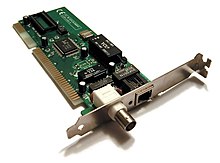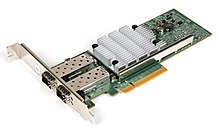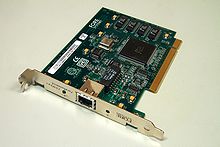
Ethernet is a family of wired computer networking technologies commonly used in local area networks (LAN), metropolitan area networks (MAN) and wide area networks (WAN). It was commercially introduced in 1980 and first standardized in 1983 as IEEE 802.3. Ethernet has since been refined to support higher bit rates, a greater number of nodes, and longer link distances, but retains much backward compatibility. Over time, Ethernet has largely replaced competing wired LAN technologies such as Token Ring, FDDI and ARCNET.

Wake-on-LAN is an Ethernet or Token Ring computer networking standard that allows a computer to be turned on or awakened from sleep mode by a network message.
Direct memory access (DMA) is a feature of computer systems that allows certain hardware subsystems to access main system memory independently of the central processing unit (CPU).
Internet Small Computer Systems Interface or iSCSI is an Internet Protocol-based storage networking standard for linking data storage facilities. iSCSI provides block-level access to storage devices by carrying SCSI commands over a TCP/IP network. iSCSI facilitates data transfers over intranets and to manage storage over long distances. It can be used to transmit data over local area networks (LANs), wide area networks (WANs), or the Internet and can enable location-independent data storage and retrieval.

InfiniBand (IB) is a computer networking communications standard used in high-performance computing that features very high throughput and very low latency. It is used for data interconnect both among and within computers. InfiniBand is also used as either a direct or switched interconnect between servers and storage systems, as well as an interconnect between storage systems. It is designed to be scalable and uses a switched fabric network topology. Between 2014 and June 2016, it was the most commonly used interconnect in the TOP500 list of supercomputers.
In computer networking, promiscuous mode is a mode for a wired network interface controller (NIC) or wireless network interface controller (WNIC) that causes the controller to pass all traffic it receives to the central processing unit (CPU) rather than passing only the frames that the controller is specifically programmed to receive. This mode is normally used for packet sniffing that takes place on a router or on a computer connected to a wired network or one being part of a wireless LAN. Interfaces are placed into promiscuous mode by software bridges often used with hardware virtualization.
TCP offload engine (TOE) is a technology used in some network interface cards (NIC) to offload processing of the entire TCP/IP stack to the network controller. It is primarily used with high-speed network interfaces, such as gigabit Ethernet and 10 Gigabit Ethernet, where processing overhead of the network stack becomes significant. TOEs are often used as a way to reduce the overhead associated with Internet Protocol (IP) storage protocols such as iSCSI and Network File System (NFS).

A network processor is an integrated circuit which has a feature set specifically targeted at the networking application domain.

QEMU is a free and open-source emulator. It emulates a computer's processor through dynamic binary translation and provides a set of different hardware and device models for the machine, enabling it to run a variety of guest operating systems. It can interoperate with Kernel-based Virtual Machine (KVM) to run virtual machines at near-native speed. QEMU can also do emulation for user-level processes, allowing applications compiled for one architecture to run on another.
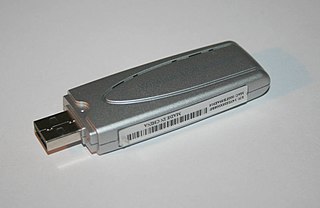
A wireless network interface controller (WNIC) is a network interface controller which connects to a wireless network, such as Wi-Fi, Bluetooth, or LTE (4G) or 5G rather than a wired network, such as an Ethernet network. A WNIC, just like other NICs, works on the layers 1 and 2 of the OSI model and uses an antenna to communicate via radio waves.
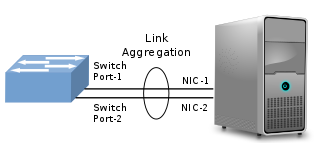
In computer networking, link aggregation is the combining of multiple network connections in parallel by any of several methods. Link aggregation increases total throughput beyond what a single connection could sustain, and provides redundancy where all but one of the physical links may fail without losing connectivity. A link aggregation group (LAG) is the combined collection of physical ports.
In computer networking, jumbo frames are Ethernet frames with more than 1500 bytes of payload, the limit set by the IEEE 802.3 standard. The payload limit for jumbo frames is variable: while 9000 bytes is the most commonly used limit, smaller and larger limits exist. Many Gigabit Ethernet switches and Gigabit Ethernet network interface controllers and some Fast Ethernet switches and Fast Ethernet network interface cards can support jumbo frames.
iWARP is a computer networking protocol that implements remote direct memory access (RDMA) for efficient data transfer over Internet Protocol networks. Contrary to some accounts, iWARP is not an acronym.
In computing, Microsoft's Windows Vista and Windows Server 2008 introduced in 2007/2008 a new networking stack named Next Generation TCP/IP stack, to improve on the previous stack in several ways. The stack includes native implementation of IPv6, as well as a complete overhaul of IPv4. The new TCP/IP stack uses a new method to store configuration settings that enables more dynamic control and does not require a computer restart after a change in settings. The new stack, implemented as a dual-stack model, depends on a strong host-model and features an infrastructure to enable more modular components that one can dynamically insert and remove.
The Killer NIC, from Killer Gaming, is designed to circumvent the Microsoft Windows TCP/IP stack, and handle processing on the card via a dedicated network processor. Most standard network cards are host based, and make use of the primary CPU. The manufacturer claims that the Killer NIC is capable of reducing network latency and lag. The card was first introduced in 2006.
ethtool is the primary means in Linux kernel-based operating systems for displaying and modifying the parameters of network interface controllers (NICs) and their associated device driver software from application programs running in userspace.

The Dell blade server products are built around their M1000e enclosure that can hold their server blades, an embedded EqualLogic iSCSI storage area network and I/O modules including Ethernet, Fibre Channel and InfiniBand switches.
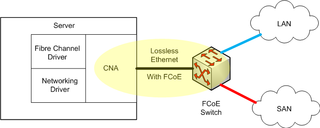
A converged network adapter (CNA), also called a converged network interface controller (C-NIC), is a computer input/output device that combines the functionality of a host bus adapter (HBA) with a network interface controller (NIC). In other words, it "converges" access to, respectively, a storage area network and a general-purpose computer network.
The Data Plane Development Kit (DPDK) is an open source software project managed by the Linux Foundation. It provides a set of data plane libraries and network interface controller polling-mode drivers for offloading TCP packet processing from the operating system kernel to processes running in user space. This offloading achieves higher computing efficiency and higher packet throughput than is possible using the interrupt-driven processing provided in the kernel.
XDP is an eBPF-based high-performance data path used to send and receive network packets at high rates by bypassing most of the operating system networking stack. It is merged in the Linux kernel since version 4.8. This implementation is licensed under GPL. Large technology firms including Amazon, Google and Intel support its development. Microsoft released their free and open source implementation XDP for Windows in May 2022. It is licensed under MIT License.
